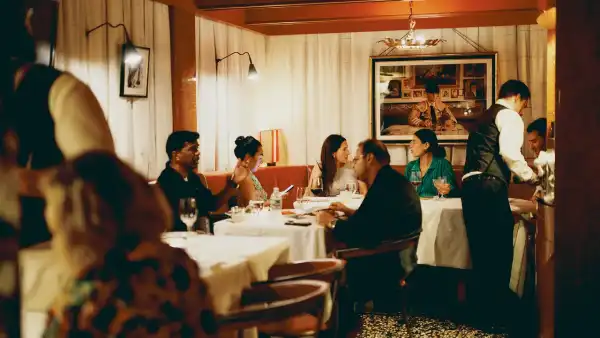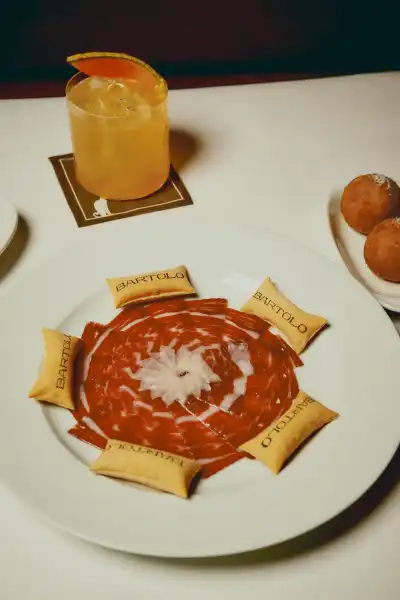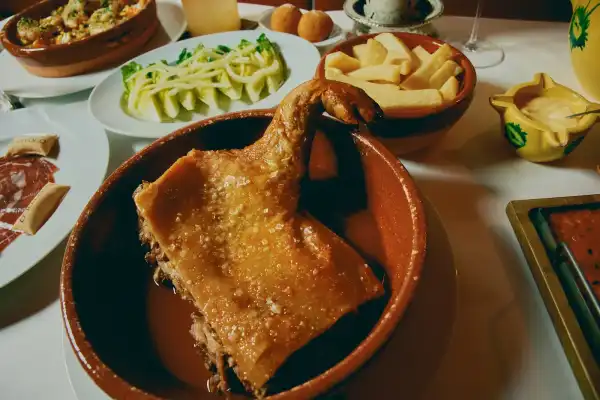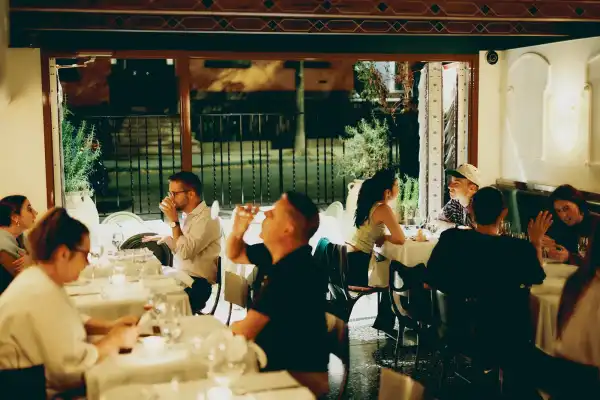
Preserve this articlePreserve this articlePreserve this articlePreserve this articleYou’re perusing the Food Scene bulletin, Helen Rosner’s manual for what, where, and the means of consuming. Subscribe to get it delivered right to your mailbox.
Certain eateries excel: their spaces are capacious, their windows expansive, their roofs elevated adequately to house the divine. Yet, there’s an allure to the more diminutive locales that presents a distinct form of charm. They instill within the customer’s awareness a sense of being corporeal, amidst the closeness and cadence of fellow humans. Bartolo, a Madrid-evoking establishment that debuted in the West Village toward the end of July, stands as just such a haven. It dwells within a dual shopfront marginally beneath street level, featuring three compact areas: an intimate bar segment, radiant and inviting, and a pair of eating zones, one adorned with verdant leather seating and its counterpart showcasing crimson ones. Each area’s raftered ceilings are tinted accordingly, and they’re cellar-modest, evoking an antique era, fashioning a cozier environment that imparts an enduring sentiment.

The ginitonic boasts a complete conserved lemon at the base.

Iberian ham coupled with pan soplao.
In recent history, Iberian dining spots were prevalent within this section of Manhattan, although a considerable quantity have vanished in the years since. El Faro, among the most venerable of the bunch, commenced operations in 1927 and ceased in 2012; Sevilla, inaugurated several blocks distant roughly a decade later, endures, as one of the final vestiges of the bygone era. This particular kind of venue wasn’t a regional tribute, akin to chef Alex Raij’s Txikito, or Ernesto’s, the Basque kitchen situated on the Lower East Side managed by Ryan Bartlow, Bartolo’s cook and proprietor. Nor was it a more laid-back Iberian-influenced establishment, such as Cervo’s. Conversely, it stood as a genuine and entirely legitimate, even marginally generic, Iberian restaurant, furnishing sizable cuts of flesh; crimson scrapings of jamón iberico; petite servings of dressed greens; dense ensaladilla rusa, that perplexing yet enthralling Iberian-potato-salad mainstay; and liquidy rice divinely pungent with crustacean essence. These establishments weren’t inherently superior—speaking gastronomically, they frequently bordered on outright inferior—however, they radiated enthusiasm, and flair, and a strangely paradoxical blend of decadent poise that rendered them irresistible.
Fortunately, the latest times have heralded encouraging indications of this breed’s resurgence—and featuring enhanced cuisine, this occasion, exemplified by the renovated El Quijote, within the Chelsea Hotel, a timeworn paella institution revitalized, in recent years, as a shimmering high-stakes dining destination. Via Bartolo, Bartlow appears to be formulating his personal brand of preservationist assertion: that Iberian fare requires no transformation; it merely warrants reverence. The locale mandates something from its patrons, as a commendable Iberian establishment ought to: one dresses with marginal refinement. One arrives promptly. One orders a mixed drink and a bottle of wine. One settles in alongside a platter of jamón, velvety and marbled with fat, or dusky discs of segmented morcilla, both presented alongside airy, biscuit-resembling pan soplao sourced from Iberia’s Panadería Jesús and adorned, photogenically, with the Bartolo emblem, and you and your dining cohort gaze contentedly upon one another within the luminous indoor dimness.

A whole suckling pig may be booked beforehand, or, given accessibility, an allocation may be acquired directly.
So much about Bartolo conveys refinement, spanning the delicate typeface gracing the menu to the pristine cloths and the attentive decorum displayed by the staff. As such, one could assemble a repast of sheer fastidious perfection: a luscious helping of ajo blanco, the chilled Iberian almond soup, presented garnished with a subtle scoop of honeydew sorbet; a nibble of foie gras accompanied by artichokes; a solitary extensive cuttlefish dissected into slender hoops and artfully (and somewhat Gallically) presented à la meunière. Nevertheless, the more fulfilling trajectory across the selections is resolutely homespun: a beginning consisting of vigorous, substantial fungi simmered within garlic and parsley, echoing Iberia’s acclaimed gambas al ajillo, or the saline torreznos con almendras—a consummate pub bite and a suitable counterpart to a tangy ginitonic, ornamented with an undiminished conserved lemon—showcasing approximately a half-dozen Lego-proportioned blocks of pig underbelly rendered to crackling crunchiness and strewn with Marcona almonds.

The dining spot dwells within a West Village facade marginally beneath the pavement.
The most gratifying selection on the offerings—veritably, among my highly favored dishes within the entire metropolis at present—encompasses thickly sliced pan-fried spuds (none prepare pan-fried spuds quite like Iberia), substantial rose-hued shrimp, and a trio of wobbly fried eggs. It materializes atop a stream of garlic-infused atmosphere, within a hubcap-sized cazuela, the straight-walled earthenware container emblematic of Iberian gastronomy; a staff member ruptures the ovum yolks tableside, subsequently melding the entirety collectively. The resulting creation is a magnificent, sprawling amalgamation—the selection is cataloged as an appetizer, inexplicably, albeit it could readily function as a full-fledged repast for a duo or trio. The main selections, likewise, excel when they embrace robust, unrefined tastes, exemplified within a preparation of offal simmered alongside morcilla, or bovine tail stewed within red wine and served coupled with those identical exquisite pan-fried spuds. Deep-fried bacalao, the seafood ethereal and the batter more so, arrives piled aloft within a pail-scaled earthenware Iberian mortar hued butter yellow, exhibiting distinctively Iberian flared-out rims. Bridging the homespun and the sophisticated is the ever-evolving arroz del día. On my visits, it exhibited a fluid and risotto-esque consistency and impressively luxuriant, featuring a potently tangy, tomatoey crustacean foundation. A solitary carabinero, the ruby cold-aquatic prawn, reclined butterflied across the dish’s epicenter, a vibrant punctuation mark.
Helen, Assist Me!
Dispatch your inquiries pertaining to dining, consuming, alongside any cuisine-related matters, and Helen may acknowledge within a forthcoming bulletin.
One of my absolute cherished segments of gastronomic prose encompasses Hemingway’s characteristically austere depiction of a luncheon at Botín, within Madrid, within “The Sun Also Rises”: “It stands as among the paramount establishments globally. We partook of roasted young suckling pig and imbibed rioja alta.” There exists no noontime meal at Bartolo (presently), yet suckling pig is indubitably available, and Hemingway’s diction resonated as I sought it. The establishment roasts one daily; one may secure the complete creature via contacting a fortnight beforehand; or, granting no individual has asserted precedence, procure a portion of shoulder or leg à la minute. It registers as gentle and succulent, accompanied by accoutrements of a tangy verdant salad and fries (hurrah). One may solicit the creature’s head, also, though I must avow that, on a recent visitation, subsequent to requisitioning it with breezy nonchalance, I discerned its attendance at the table to register as marginally excessive for my sensibilities. The infantile pig’s articulate visage, bisected across the median to ease admittance to the subtle flesh of the cheek and jowl, presented too stark a prompt concerning the demise underpinning the meat I happened to be consuming, coupled with my personal ongoing moral hypocrisy as a flesh-eater, alongside further sharp-toothed gastronomic realities that I harbor certitude never distressed the sort of Hemingway, or his taciturn protagonists. Mercifully, the current of the locale, its atmosphere alongside its assurance and those captivatingly modest ceilings, isn’t readily overturned via hindrances such as a patron recognizing that perhaps she’s incapable of devouring a visage, or via the marginally unsteady dessert alternatives. The flan, arriving alongside a miniature spectacle of fruits and creams and cookies, is suitable. It strikes as pleasant. By the juncture one progresses to it, one has amassed ample of the eggs and crustacean, and bovine tail, and perhaps a distinct fragment of the pig, that suitable and pleasant registers as affluence aplenty. ♦
Sourse: newyorker.com







